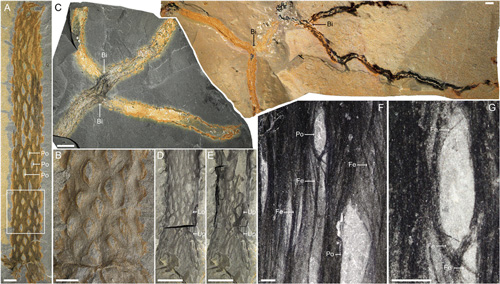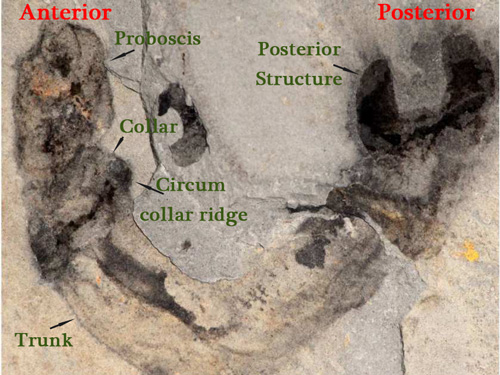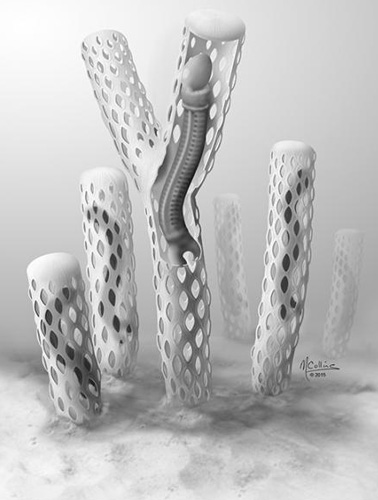The Secretive and Solitary Oesia disjuncta
Research carried out by UK and Canadian academics has shed light on how Cambrian life-forms may have led to more complex creatures including vertebrates and ultimately our own species. It turns out that a small sea worm Oesia disjuncta with its mix of anatomical traits, might point the way towards a better understanding of the Kingdom Animalia. The fossils of Oesia have also provided evidence about how these worms kept themselves safe against the ever increasing number of predators by building long, tube-like homes to live in.
Oesia disjuncta
According to the scientists, whose work is published in the academic journal “BMC Biology”, the ancient Cambrian sea bed may have been marked by perforated tubes that resembled “exceedingly thin brandy snaps”, as one Everything Dinosaur team member reported it. Some of these structures may have been more than five hundred millimetres in length, gargantuan by Cambrian standards. The study, undertaken by scientists from the Royal Ontario Museum (Toronto, Canada), Cambridge University and two other Canadian universities (Toronto and Montréal), originated from a reassessment of fossils that were thought to have represented a type of marine green algae (Margaretia dorus).
Marble Canyon Quarry Oesia Fossil
Picture credit: Royal Ontario Museum with additional annotation by Everything Dinosaur
To give an impression of scale of the specimen, the width of the photograph above is approximately three centimetres.
Learning More About Oesia disjuncta
Oesia disjuncta, the only species within the Oesia genus, has been known to science for more than 100 years. It was described in 1911 by the great Charles D. Walcott, the American geologist who had discovered the Burgess Shale deposits (British Columbia, Canada) and the abundance of Cambrian fossils that they contain, two years earlier. It had been described as a type of annelid marine worm (segmented worm), but this classification had subsequently fallen out of favour and a number of affinities had been suggested such a Oesia representing a basal chaetognath (arrow worm).
Recently, it had been proposed that this creature was taxonomically closer to the hemichordates, animals like acorn worms that have closer affinities to the chordates than they do to the Echinodermata (starfish, sea lilies, brittle stars and sea urchins. This research supports the hypothesis that O. disjuncta should be placed within the hemichordates, which means it forms a link between marine worms and all the animals with backbones (vertebrates) and this includes our own species – H. sapiens. The genus name for this worm, which lived a solitary life inside the protection of its tube, comes from a small lake (Lake Oesia), located just a few miles from the Burgess Shale quarry where the first fossils of this ancient animal were found.
An Illustration of Oesia Worms in their Tubes
Picture credit: Marianne Collins
The Importance of the Marbel Canyon Site
In 2012, a new highly fossiliferous site was discovered, around 25 miles from the original Burgess Shale fossil quarries excavated by Walcott. This location has yielded many more examples of Oesia and they are generally better preserved than the specimens discovered in the previous century. The new quarries have yielded a number of new species as well as shedding more light on already described genera. A study of these specimens has confirmed that Oesia was most likely a basal member of the hemichordates. As such, being a hemichordate, it is nested within the superphylum Deuterostomia which also includes the vertebrates (amongst others).
Lead Author Karma Nanglu Pausing on the Trail up to the Marble Canyon Quarry

University of Toronto PhD student and lead author Karma Nanglu on the trail leading up to the Marble Canyon site.
Picture credit: Joe Moysiuk
Unravelling the Origins of Today’s Phyla
The bulk of the Kingdom Animalia which are more complex than the cnidarians (jellyfish), with their radial symmetry, are divided into two main groups:
- Deuterostomia – bilateral symmetry mainly, with only the echinoderms showing radial symmetry, this group includes the vertebrates and acorn worms etc.
- Protostomia – bilateral symmetry including the molluscs, arthropods, nematodes and worms.
These lineages are believed to share a common ancestor that lived during the Ediacaran geological period. With the placing of Oesia within the deuterostomes, scientists hope that they may be able to identify the distant common ancestor of all the Deuterostomia.
A Filter Feeder
With more data on Oesia, it suggests that this common ancestor was very probably a “filter feeder”, sucking in water and straining out nutrients that were trapped on gill structures. Oesia was such a filter feeder with “u-shaped” gills running down most of its body length. The tube-like structure it lived in was highly porous, this would have allowed water to flow in and out of the tube aiding filter feeding.
Lead author of the research Karma Nanglu (University of Toronto) stated:
“Hemichordates are central to our understanding of how deuterostomes evolved. Through them, we can get clues about the anatomy and lifestyle of the last common ancestor that we all share, and this adds further evidence to the hypothesis that the ancestor was a filter-feeder like Oesia.”
The tubes were quite spacious for Oesia, they are at least twice as wide as the creature’s body and many times longer.
Co-author of the scientific study, Professor Simon Conway Morris (Cambridge University) added:
“Oesia fossils are pretty enigmatic, they are very rare and until now we could not prove which group they belonged to. Now we know that they were primitive hemichordates – perhaps the most primitive of all.”
This new research establishes Oesia was similar to extant marine acorn worms. These worms have a proboscis, a reproductive collar region and a long, narrow body. The tube may have acted as a sanctuary protecting the soft-bodied worm from an array of rapidly evolving predators.
Not Associated with Margaretia dorus
The researchers realised that Oesia must have lived in tubes because among the Marble Canyon finds there are dozens of examples where the fossil remains of the worm are found within those of what was thought to be the remains of the green algae Margaretia dorus.
Oesia also hints that at some point, acorn worms underwent an evolutionary development that led to them leaving their tubes and opting for an existence burrowing in the mud of the sea bed. The researchers suggest that as more efficient predators evolved, living in the mud at the bottom of the sea may have been a more advantageous lifestyle. Extant acorn worms occupy this niche, rather than an epifaunal, filter feeding habit, they live in the sediment and feed on the nutrients that it contains.
Fossils Reveal the Tube-Like Structures of Oesia

Fossils of the tube-like structures once thought to be algae but now identified as the home of Oesia worms.
Picture credit: BMC Biology
Professor Conway Morris explained:
“In its own depressing way this is a story of Darwinian competition. The levels of competition and predation increased, life sped up and got harder and animals had to protect themselves more. One way of doing this was to abandon life filter feeding in a tube, and instead to dig into the sediment and eat mud. Once there, they found a new niche and were able to make a perfectly good life for themselves.”
The study, “Cambrian suspension-feeding tubicolous hemichordates”, is published in the journal BMC Biology. Everything Dinosaur acknowledges the assistance of the Royal Ontario Museum in the compilation of this article.
Visit Everything Dinosaur’s award-winning website: Everything Dinosaur.








Leave A Comment